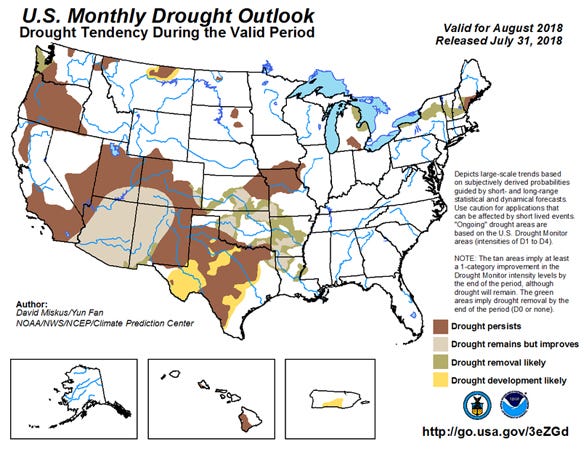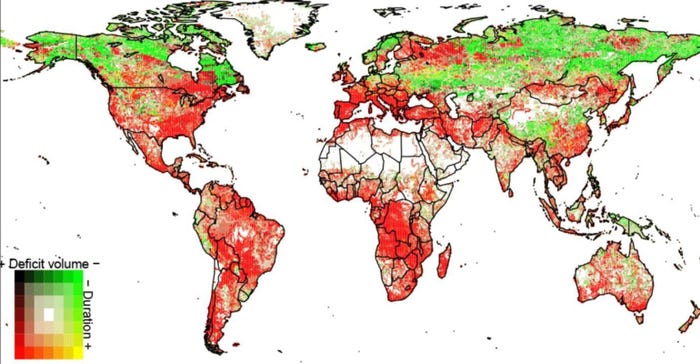August 27, 2018

Michigan is in a flash drought situation, says state climatologist Jeffrey Andresen of Michigan State University Extension.
“We have gone from one extreme in April to drought a couple of months later,” he says.
“We went from the second-coldest April, with record snowfall, to the fifth-warmest May, and then precipitation below normal in June and July.”
Andresen, professor of meteorology and climatology, says the warmer the air, the more water vapor it can hold, accelerating the loss of rain. “We began seeing drought stress in June and it worsened,” he says. “There was some rain in the last days of July, but some areas are in drastic need of water.”

The U.S. drought situation as of July 24, according to NOAA.
The big dry was happening at a time when corn and soybean crops were at vulnerable stages of development.
“Already there are some crop losses,” Andresen says. “Hay and forage is down; fruit size is smaller.”
He says Michigan and the Great Lakes area is becoming warmer in the last few decades with heavy rain events increasing.
The U.S. Drought Monitor shows abnormal dryness or drought is affecting about 8.8 million people in Michigan, about 89% of the state's population.
The monitor, as of Aug. 21, has 5.36% of Michigan in severe drought, 27.98% in moderate drought and 24.55% of the state abnormally dry.
Global drought issue
Stick a pin anywhere on a world map and you’re likely to strike a drought. In a rare combination, droughts are gripping large areas in Australia, South Africa, Asia, North America, Scandinavia, Russia, western Europe, and even the United Kingdom and Ireland.
 NATIONAL OUTLOOK: This map shows the changes in duration and intensity of drought in the 21st century. The red colors indicate an increased probability of droughts. Green indicates a probable decrease in droughts in some areas.
NATIONAL OUTLOOK: This map shows the changes in duration and intensity of drought in the 21st century. The red colors indicate an increased probability of droughts. Green indicates a probable decrease in droughts in some areas.

Andresen says climatologists look to the jet streams in the Northern and Southern Hemispheres as the reason so many areas are seeing drought conditions. “I don’t think you can say the two are independent,” he says. “The real direct physical cause is the flow of the jet streams. They control surface weather patterns in the mid- and upper latitudes.”
The jet stream flows from west to east, but also moves north and south. The flow is becoming more north-south meandering as the Earth warms. “The real critical issue is its prolonged stationary location,” Andresen says. “We are seeing a blocking, stalled jet stream pattern.”
That is bringing on drought and heat waves.
Drought Down Under
Drought-prone Australia is once again gripped by the big dry, with the April to June period the fourth-driest one since records commenced in 1900.
The entire state of New South Wales was declared a drought area for the first time. As reported in the Australian newspaper The Daily Telegraph, farmer Les Jones said he would have to shoot all 1,200 of his sheep and bury them on his farm because he has no grass, no water and no money to buy grain.
Massive campaigns are underway in New South Wales to raise money to buy hay for stricken farmers with thousands of bales donated. Agriculture Minister David Littleproud has announced a fourth year of drought aid.
The Farm Household Allowance, which provides help for farmers facing drought, was introduced in 2014. It has been paid to almost 8,000 farmers at a cost if A$230 million (US$167 million).
The New Zealand Drought Monitor shows with winter in place, the country is out of drought. However, National Institute of Water and Atmospheric Research meteorologist Ben Noll says from January to June this year, record or near-record high mean monthly temperatures were reached 163 times.
January was the warmest month on record, and New Zealand has not had a month with below-average nationwide temperatures since January 2017.
Andrew Burtt, chief economist for Beef + Lamb New Zealand Ltd., says there’s almost always a drought now each summer — somewhere.
“The most recent, notable one was in North Canterbury, it lasted for a couple of years … and has had lingering effects since,” he tells Michigan Farmer.
Low precipitation in Japan
Meantime, Japan has an unprecedented shortage of water in lakes and reservoirs after unusually low snowfall last winter and a lack of rain since.
The eight reservoirs in the Kanto area were at 39% capacity, down from 54% a year ago and at the lowest level in 25 years. At least 65 people have died in Japan from the blistering heat since early July.
“We are observing unprecedented levels of heat in some areas,” a weather agency spokesman tells reporters.
In South America, a drought that started in southeast Brazil in 2014, called the worst in 80 years, ended last year.
Karl Setzer, Risk Management Team Leader at Iowa-based MaxYield Cooperative, says that at this time there is no major drought being reported in South America.
“We are seeing a shift to an El Niño-type weather pattern, which normally brings favorable growing conditions to South America,” he says.
In western Canada, the area affected by drought continues to improve, but there are still pockets of drought in southern regions.
This after a large portion of those regions, from the British Columbia interior to the southeastern Prairies, last year experienced the driest summer in 70 years with less than half the normal rainfall.
In the United States, California, Arizona and New Mexico are gripped by drought, heat and uncontrolled wild fires.
Jason Banta, Texas A&M University AgriLife Extension beef cattle specialist, wants producers to consider culling options in case the drought in the Southwest continues to lower forage and hay availability.
In a statement, Banta says drought conditions are also affecting hay availability in other nearby states, including Oklahoma, Kansas, Missouri and Arkansas. Severe conditions are expanding into the southern half of Iowa, and in Illinois more than 20% of the state is abnormally to moderately dry.
Meantime, 38% of Wisconsin and 18% of Minnesota are abnormally dry. Almost 25% of South Dakota is abnormally to severely dry, and 3.4% is in moderate drought.
Western Europe is also gripped by its second drought in three years.
Drought in Ireland part of larger dry area
In Ireland, Met Éireann, of the he Irish National Meteorological Service, says the little rain the Emerald Isle is getting does nothing to alleviate drought conditions.
Farmers are facing grass and water shortages. Michael Hennessy with the Agriculture and Food Development Authority says barley, wheat and oat yields are predicted to be 26% lower. Other crops such as beans and peas will see yield drops of 50% to 70%.
Gerry Bell, a meteorologist at the U.S. National Oceanic and Atmospheric Administration, says the drought in Ireland is part of a larger-scale drought pattern that extends across Europe. Another large area of drought is in central Russia.
“These two regions are separated by a large area of exceptionally moist conditions in western Russia,” he says. “The resulting three-celled pattern [of] dry-wet-dry reflects a persistent weather pattern for the past few months that has extended across the North Atlantic Ocean to central Russia.
“The wind patterns related to the drought over Europe and central Russia are linked to a persistent Northern Hemisphere circulation pattern.”
In the United Kingdom, Guy Smith, deputy president with the National Farmers Union, says an unprecedented spell of more than 40 days of sunshine and near-record temperatures has grass scorched and turning brown. He says livestock and dairy farmers are dipping into winter fodder supplies and reporting poorer fertility in beef herds.
Good rains at the end of July helped a little, but the government’s Center for Ecology and Hydrology says the figures for the last three months show a significant meteorological drought at the UK scale.
The dryness is also shown by the center’s UK Drought Portal, with most of the UK registering as “severely dry” or “extremely dry” over this period.
Drought and heat is resulting in forest fires in Scandinavia, a region not set up to fight them, and authorities there had to call for international assistance.
In Sweden, the Lantmännen agricultural cooperative owned by 25,000 farmers predicts the 2018 harvest will dive to 4.2 million tonnes, more than 30% below the five-year average after extreme heat and drought in May and June.
“Ultimately, we're talking about Sweden’s food supply,” says Mikael Jeppsson, head of the grain unit at Lantmännen. “Sweden will be more dependent on wheat imports and go from being a net exporter to a net importer.”
The situation looks similar across the entire Baltic Sea area.
The Russian Meteorological Service says hot, dry conditions are threatening winter wheat crops in Russia’s southern regions that have not received rain since April. Two-thirds of southern Russia, one of the world's largest grain producers, is in drought.
The European Union’s Joint Research Centre's (JRC) June report says several countries in the Middle East and Central Asia are suffering from drought.
“As a result of the dry conditions that persist since this winter, the productivity of pastures and rain-fed cereals is clearly reduced in much of Central Asia, including Afghanistan, Turkmenistan, Uzbekistan and Tajikistan,” the JRC says.
In southern Africa, it says, production expectations are below average in southern Madagascar and in regions that experienced a major dry spell early in the season, including southern Mozambique, southern Malawi, Lesotho, southern Zimbabwe and southern Zambia.
South Africa has imposed tight water usage restrictions after three years of drought. Marine salvage experts are proposing towing icebergs from Antarctica to Cape Town to help with the worst water shortage in a century.
A JRC technical report found the massive water shortage, while exceptional, is characteristic of longer-term weather patterns. With climate change spurring more extreme weather events, severe shortages could become an increasingly regular occurrence, it says.
JRC scientists looked at precipitation in southern Africa over the past 36 years and found a strong probability of a 50% to 70% monthly precipitation deficit every five year.
In South Africa’s Western Cape, the deficit could reach as high as 70% to 80% every 10 years.
Denene Erasmus, editor of South Africa’s Farmers Weekly, in a poignant letter to farmers in the country’s drought-stricken regions, said anyone who has grown up on a farm knows the excruciating helplessness of looking out over parched veld or crops and watching rain fall from heavy clouds on another family’s farm.
Erasmus says her recent memories of the family farm are largely filled with anxiety and tension as November, and then December, and then January arrived without bringing rain.
“Drought, I have now learnt, brings with it its own violent silence,” she wrote. “I would like to say only this: to those farmers in the Western, Northern and Eastern Cape, as well as those in all the other parts of the country where drought prevails, and farmers continue to suffer its savagery, I am waiting with you for this deathly silence to end.”
Harman writes from Brighton, Mich.
About the Author(s)
You May Also Like




